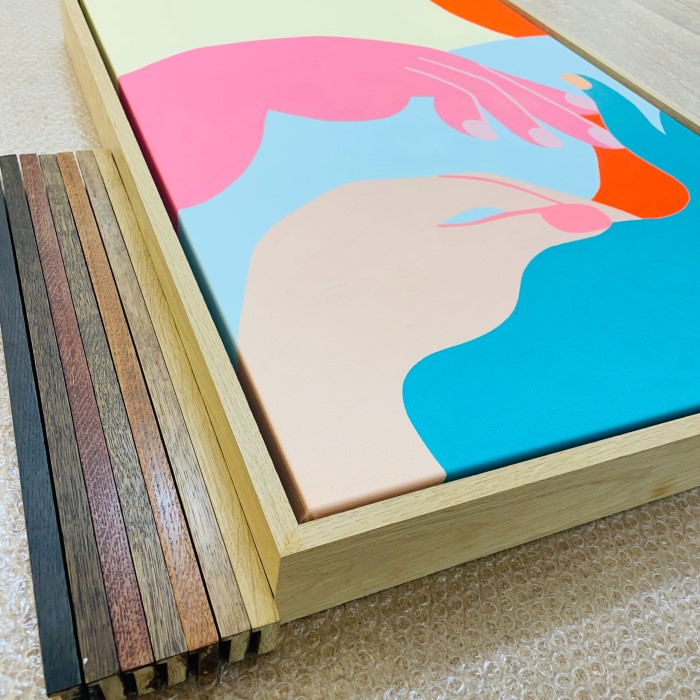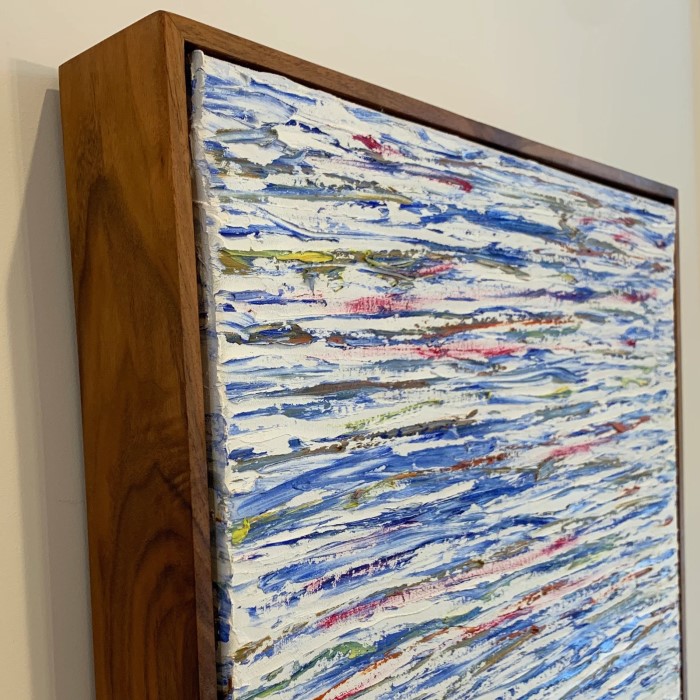Introduction to Choosing Frames for Canvas Paintings
Selecting the right frame for canvas painting is an essential part of showcasing your artwork beautifully. A well-chosen frame enhances the art and adds an element of finish to your decor. However, the process can be overwhelming due to numerous options available in framing styles, materials, and colors. This guide simplifies that process by highlighting the critical do’s and don’ts when choosing a frame for your canvas paintings.

When choosing the perfect frame, consider several aspects such as the art itself, the room’s decor, and your personal style preferences. The right frame can elevate your canvas from a simple work of art to a stunning focal point in your home. This article will delve into practical advice to ensure your framing choice complements and enhances your canvas paintings.
Why Framing a Canvas Painting Matters
Framing a canvas painting is more than just a decorative choice. It serves both practical and aesthetic purposes.
Protects the Artwork
A frame helps shield the painting from dust, dirt, and physical damage. It adds an extra layer of protection, especially for valuable or sentimental pieces.
Enhances Visual Appeal
Frames complement the painting by highlighting its colors, textures, and details. They create a polished and complete artistic presentation.
Preserves Longevity
Framing can reduce exposure to environmental elements like humidity and sunlight. This helps maintain the artwork’s vibrancy and structure over time.
Defines the Space
A well-chosen frame anchors the painting to its surroundings. It ensures the artwork blends seamlessly with your interior decor.
Adds Value
A professionally framed canvas often appears more valuable. It gives a gallery-quality feel to your painting.
Framing a canvas painting plays an essential role in protecting and showcasing the artwork. It makes your art stand out while ensuring it lasts for years to come.
Types of Frames for Canvas Paintings
Choosing the right type of frame enhances the beauty of your canvas painting. Different frame styles provide unique looks and functionalities. Let’s explore the three main types of frames:
Traditional Frames
Traditional frames are classic and versatile. They often come with ornate designs and intricate details. They work well with traditional or vintage-style paintings. You can find them in materials like wood or metal with finishes such as gold, silver, or natural stains. These frames add charm and elegance to your canvas and surroundings.

Floater Frames
Floater frames create a modern and sleek appearance. The canvas sits slightly inside the frame, leaving a visible gap. This gives the illusion that the painting is floating in the frame. Floater frames are ideal for showcasing contemporary and minimalist art. They often come in neutral colors like black or white to keep the focus on the painting.
Box Frames
Box frames provide depth and dimension to your artwork. The canvas is encased within a deep wooden or metal frame. This type of frame protects the painting from external elements. Box frames suit modern, abstract, or three-dimensional works. They also work well in spaces with minimalist or industrial decor.
When selecting a frame for canvas painting, understanding these types can simplify your decision. Each frame style has its unique appeal, complementing different art styles and settings.
Factors to Consider When Selecting a Frame
Choosing the right frame for canvas painting involves several crucial factors. A well-selected frame enhances your artwork and complements your space.
Style and Aesthetic
Choose a frame that matches your painting’s style. For traditional art, ornate or classic frames work well. Minimalist or abstract pieces look great with simple, sleek frames. Consider your room’s decor and ensure the frame contributes to the overall harmony.
Size and Proportions
The frame should suit the canvas dimensions. Avoid oversized or too-small frames for balanced proportions. The frame’s depth should align with the canvas thickness. A well-fitted frame highlights your painting without overpowering it.
Material and Finish
Frame materials like wood, metal, or resin offer different aesthetics and durability. Wooden frames add warmth, while metal frames give a modern touch. Choose finishes such as matte, glossy, or distressed to accentuate the art. Ensure the material complements the painting’s colors and textures.
Considering these factors will help you select the perfect frame for canvas painting. A thoughtful choice ensures the frame enhances both the artwork and your living space.
How to Match Frames with Different Painting Styles
Matching the right frame with different painting styles is crucial for achieving a cohesive look. A well-chosen frame enhances your art while complementing the design of your space. Here are tips to guide you:
Realism and Traditional Paintings
Choose ornate or classic frames for realism and traditional art. Wood frames with intricate details work well. Gold or silver finishes can add elegance and a timeless appeal. These frames elevate the sense of tradition and craftsmanship.
Abstract and Modern Art
For abstract or modern art, go for minimalist frames. Sleek floater frames or thin box frames are popular choices. Neutral colors like black or white emphasize the artwork without distraction. Modern frames highlight the boldness and innovation of your painting.

Contemporary and Pop Art
Bright and bold contemporary art matches well with simple and colorful frames. Metal or acrylic frames can add a fresh, vibrant feel. Avoid overly ornate designs, as they can clash with the boldness of pop art.
Vintage or Rustic Style Paintings
Rustic or vintage art pairs beautifully with wooden frames. Opt for distressed finishes like natural stains or aged textures. These frames accentuate the nostalgia and charm of vintage or rustic works.
Minimalist and Neutral Paintings
Minimalist art thrives with thin, clean-lined frames. Shades like black, white, or gray create harmony. The frame should be understated, allowing your art to stand out.
By considering the painting’s style and choosing the right frame, you create visual harmony. Balance is key in ensuring the frame complements both the artwork and surrounding decor.
When to Leave a Canvas Unframed
Leaving a canvas unframed can sometimes be a smart and stylish choice. While frames provide benefits, certain situations and styles thrive without them. Here are key considerations:
Emphasize the Artwork’s Raw Appeal
Unframed canvases highlight the raw essence of the artwork. This works well for bold modern pieces and textured art. The edges of the canvas become part of the visual presentation, adding authenticity.
Suit Minimalist and Contemporary Designs
Unframed canvases often complement minimalist or contemporary spaces. They offer a casual and airy feel that blends well with modern interiors. This style creates a gallery-like atmosphere at home.
Showcase Gallery-Wrapped Canvases
Gallery-wrapped canvases are designed for frameless display. The artwork extends around the edges, offering a finished look. This technique avoids the need for traditional frames and suits various art styles.
Save on Costs
Leaving a canvas unframed can save money, especially for larger art pieces. It is a practical option for decorating on a budget while maintaining style.
Consider Practical Factors
Before leaving a canvas unframed, consider its surroundings. Ensure it’s safe from dust, moisture, and sunlight. Additionally, check if the canvas is stretched well to avoid sagging.
Ideal for Casual Spaces
Unframed canvases fit perfectly in informal settings, such as bedrooms, studios, or creative spaces. They convey a laid-back vibe and emphasize creative expression.
There are moments when leaving a canvas painting frame-free is beneficial. Whether for stylistic or practical reasons, this approach can enhance the artwork and space.
Tips for Framing Large Canvas Paintings
Framing large canvas paintings can be tricky due to their size and weight. Proper techniques ensure the artwork stays secure and looks stunning. Here’s a guide to help:
Choose Sturdy Materials
Opt for durable frame materials like hardwood or metal. These materials can support heavier canvases without sagging or bending over time.
Assess the Canvas Depth
Match the frame’s depth with the canvas thickness. Ensuring compatibility creates a clean and seamless look.
Check Wall and Space Limits
Before framing, measure the wall space where the painting will hang. Ensure the canvas and frame fit comfortably in the chosen location.
Use Reinforced Framing Techniques
Large canvases require extra security. Include corner brackets or metal stays inside the frame for additional support.
Avoid Overly Ornate Designs
Choose simple frame styles for oversized art pieces. Ornate frames may overwhelm the artwork or decorate excessively.
Consider Professional Installation
Large paintings can be challenging to handle. Hire professionals to frame and mount the artwork safely.
Opt for a Floating Design
Floater frames can create a sleek and modern look. They also work well with minimalist interiors without adding excessive weight.
Pay Attention to Weight Distribution
Large frames can strain walls if not distributed correctly. Use heavy-duty wall anchors to safely bear the load.
Customize Frames for Unique Sizes
Big canvases may need custom frames. Tailored solutions ensure a well-fitted and polished appearance.
Framing large canvas paintings takes patience and careful planning. By following these tips, you’ll showcase your art beautifully and securely.
Maintaining and Caring for Your Framed Canvas
Proper maintenance extends the life and beauty of your framed canvas paintings. Here are key tips to ensure their longevity:
Regular Dusting and Cleaning
- Use a soft, dry cloth or a feather duster to remove dust on the frame and canvas.
- Avoid liquid cleaners or sprays, as these might damage the painting.
- For intricate frames, use a small brush to clean the details gently.
Protect from Direct Sunlight
- Hang framed canvases away from direct sunlight to prevent fading and discoloration.
- Use UV-protective glass or coatings for frames in sunlit areas.
Control Humidity Levels
- Maintain consistent humidity levels to avoid warping or mold growth on the canvas or frame.
- Use a dehumidifier in very humid climates or locations.
Avoid Extreme Temperature Changes
- Keep framed artwork away from heat sources, like fireplaces or radiators.
- Sudden temperature shifts can damage both the frame and canvas material.
Inspect for Damage Periodically
- Regularly check for loose frame corners or cracks in the frame.
- Look for signs of stretching or sagging in the canvas.
- Address issues promptly to prevent further damage.
Handle with Care
- When moving framed artwork, hold it by the sides and avoid touching the canvas.
- Wrap the frame in bubble wrap or protective material during transportation.
Use Proper Hanging Techniques
- Use strong, secure hooks and wires that support the frame’s weight.
- Periodically check that the hanging hardware remains intact and sturdy.
Keep Away from Moisture
- Avoid hanging framed canvas paintings in bathrooms or damp areas.
- Moisture can weaken the frame and harm the artwork.
By following these care tips, you can ensure your frame for canvas painting remains beautiful and secure for years. Regular maintenance also helps preserve the original charm and vitality of your artwork.
Professional Framing vs DIY Framing: Which to Choose
Choosing between professional framing and DIY framing depends on your needs and preferences.
Professional Framing
- Guaranteed Quality: Professional framers ensure high-quality results with precise workmanship.
- Customization Options: Specialists offer a variety of designs, materials, and finishes.
- Protection: They use protective methods against moisture, sunlight, and physical damage.
- Expert Guidance: Professionals help match frames with your painting style and room decor.
- Convenience: You avoid handling heavy tools and technical challenges.
- Cost Consideration: Professional framing can be expensive, especially for larger or complex projects.
DIY Framing
- Cost-Effective: DIY framing saves money, especially for simple or small pieces.
- Creative Freedom: You can design frames to match your personal taste.
- Learning Opportunity: It gives you a chance to learn new skills.
- Flexibility: You work at your convenience without strict schedules.
- Material Control: You choose your preferred frame materials within your budget.
- Skill Requirement: DIY framing requires patience and basic carpentry skills.
- Risk of Errors: Mistakes in measurements or assembly can affect the final look.
Choosing the Best Option
Consider these factors to decide:
- Budget: Opt for DIY if cost is a concern; choose professional for valuable art pieces.
- Skill Level: DIY works if you have confidence in your skills; otherwise, hire a framer.
- Project Complexity: For detailed or large canvases, professionals may be the better choice.
- Time Availability: DIY framing can be time-consuming; professional services save time.
Both methods have pros and cons. Choose based on your resources and artwork importance.
Conclusion: Frame Your Art with Care
In summary, choosing the right frame for canvas painting involves careful consideration of both your artwork and your interior environment. By following the do’s and avoiding the don’ts outlined in this guide, you can select a frame that not only complements your canvas art but also enhances your overall space.
Remember, framing is not merely about protecting the artwork; it’s an extension of the art itself that can transform a piece into a striking focal point within your home. Take your time, explore various options, and most importantly, choose what resonates with you. With these tips, you’re now equipped to make informed decisions that will celebrate your canvas paintings for years to come!

